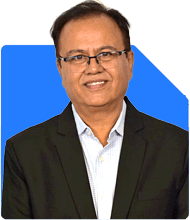Ramalingam Kalirajan |10881 Answers |Ask -Follow
Mutual Funds, Financial Planning Expert - Answered on May 23, 2024
He has an MBA in finance from the University of Madras and is a certified financial planner.
He is the director and chief financial planner at Holistic Investment, a Chennai-based firm that offers financial planning and wealth management advice.... more

Sir I am 39 year's old. Don't have much savings. Investing in share market and have accumulated a sum of 1.25 lakhs from it till now. Also have a Sip of Rs 2000 per month. Wanted to increase my SIP to 5000. Suggest few direct schemes which provides better rates of interest.
Current Financial Position and Goals
You are 39 years old with Rs 1.25 lakhs in the share market and a SIP of Rs 2,000 per month. You plan to increase your SIP to Rs 5,000 per month. This shows your dedication to building a strong financial future.
Your commitment to increasing your SIP contributions is commendable. It shows a proactive approach to securing your financial goals.
Importance of Systematic Investment Plans (SIPs)
Consistent Investing
SIPs allow you to invest a fixed amount regularly, which helps in averaging out the cost of your investments over time. This reduces the impact of market volatility.
Discipline and Convenience
SIPs promote disciplined investing and are convenient as they automate your investment process, ensuring you consistently contribute towards your financial goals.
Direct Funds vs. Regular Funds
Disadvantages of Direct Funds
Direct funds save on commission fees but lack personalized guidance. Investing through a Mutual Fund Distributor (MFD) with Certified Financial Planner (CFP) credentials ensures expert advice and strategic insights.
Benefits of Regular Funds
Regular funds offer the expertise of professional advisors who help make informed decisions, optimize your portfolio, and achieve your long-term investment goals.
Choosing the Right SIP Schemes
Diversification
It's essential to diversify your investments across different types of mutual funds to manage risk and optimize returns. Consider large-cap, mid-cap, and small-cap funds.
Fund Performance
Regularly review the performance of mutual funds. Choose funds with a consistent track record of outperforming their benchmarks.
Actively Managed Funds vs. Index Funds
Disadvantages of Index Funds
Index funds lack flexibility to adapt to market changes, potentially leading to lower returns compared to actively managed funds.
Benefits of Actively Managed Funds
Actively managed funds are overseen by professional fund managers who adjust the portfolio based on market conditions, aiming for higher returns and better risk management.
Suggested SIP Schemes
Large-Cap Funds
Large-cap funds invest in well-established companies with a strong market presence. They are relatively stable and provide steady returns.
Mid-Cap Funds
Mid-cap funds invest in medium-sized companies with potential for higher growth. They are riskier than large-cap funds but can offer better returns.
Small-Cap Funds
Small-cap funds invest in smaller companies with high growth potential. They are the riskiest but can provide significant returns over the long term.
Monitoring and Managing Your Investments
Regular Review
Regularly review the performance of your SIPs. Compare their returns with benchmark indices and peer funds. Consistent underperformance might indicate the need for a change.
Professional Guidance
Seek advice from a Certified Financial Planner (CFP). They can help you evaluate fund performance, recommend adjustments, and ensure your investments align with your goals.
Strategic Portfolio Management
Asset Allocation
Maintain a balanced asset allocation across large-cap, mid-cap, and small-cap funds. This diversification helps manage risk and optimize returns.
Regular Rebalancing
Periodically rebalance your portfolio to maintain your desired asset allocation. This involves selling overperforming assets and buying underperforming ones, ensuring your portfolio stays aligned with your goals.
Planning for Future Financial Goals
Retirement Planning
Investing in a mix of large-cap, mid-cap, and small-cap funds can help build a substantial corpus for retirement. Regular contributions and long-term growth ensure financial security in retirement years.
Child’s Education
Long-term investments are ideal for funding your child's education. Starting early and staying invested can generate necessary funds to cover higher education expenses, even for overseas studies.
Managing Market Uncertainties
Staying Invested
Market fluctuations are inevitable. Staying invested through market cycles can yield better long-term returns. Avoid making impulsive decisions based on short-term market movements.
Systematic Investment Plan (SIP)
Continue investing through SIPs. SIPs allow you to invest a fixed amount regularly, averaging out the cost of investments and reducing the impact of market volatility.
Building a Contingency Fund
Importance of Liquidity
Ensure you have an adequate contingency fund. This fund provides liquidity for emergencies, reducing the need to withdraw from your long-term investments.
Conclusion
Maintaining a long-term SIP portfolio is a sound strategy for achieving financial goals. Regular monitoring, professional guidance, and a balanced approach can help you optimize returns and manage risks. Your commitment to securing your financial future is commendable, and with the right strategy, you can achieve your retirement and other long-term goals.
Best Regards,
K. Ramalingam, MBA, CFP,
Chief Financial Planner,
www.holisticinvestment.in
You may like to see similar questions and answers below
Sunil Lala | Answer |Ask -Follow
Financial Planner - Answered on Aug 06, 2023
Ramalingam Kalirajan |10881 Answers |Ask -Follow
Mutual Funds, Financial Planning Expert - Answered on Jul 30, 2024
Ramalingam Kalirajan |10881 Answers |Ask -Follow
Mutual Funds, Financial Planning Expert - Answered on Oct 16, 2024
Ramalingam Kalirajan |10881 Answers |Ask -Follow
Mutual Funds, Financial Planning Expert - Answered on Feb 13, 2025
Dr Dipankar Dutta |1841 Answers |Ask -Follow
Tech Careers and Skill Development Expert - Answered on Dec 14, 2025
Nayagam P P |10854 Answers |Ask -Follow
Career Counsellor - Answered on Dec 14, 2025
Radheshyam Zanwar |6744 Answers |Ask -Follow
MHT-CET, IIT-JEE, NEET-UG Expert - Answered on Dec 14, 2025
Radheshyam Zanwar |6744 Answers |Ask -Follow
MHT-CET, IIT-JEE, NEET-UG Expert - Answered on Dec 14, 2025
Dr Dipankar Dutta |1841 Answers |Ask -Follow
Tech Careers and Skill Development Expert - Answered on Dec 14, 2025
Dr Dipankar Dutta |1841 Answers |Ask -Follow
Tech Careers and Skill Development Expert - Answered on Dec 13, 2025
Dr Dipankar Dutta |1841 Answers |Ask -Follow
Tech Careers and Skill Development Expert - Answered on Dec 13, 2025
Mayank Chandel |2575 Answers |Ask -Follow
IIT-JEE, NEET-UG, SAT, CLAT, CA, CS Exam Expert - Answered on Dec 13, 2025
Radheshyam Zanwar |6744 Answers |Ask -Follow
MHT-CET, IIT-JEE, NEET-UG Expert - Answered on Dec 13, 2025
Mayank Chandel |2575 Answers |Ask -Follow
IIT-JEE, NEET-UG, SAT, CLAT, CA, CS Exam Expert - Answered on Dec 13, 2025























